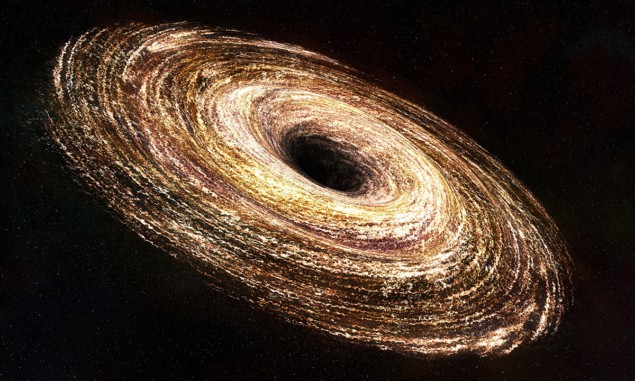
Researchers in France have created a new experiment that could improve our understanding of the dynamics of stellar and black hole accretion discs. Designed by Marlone Vernet and colleagues at the Sorbonne University of Paris, the experiment uses a combination of radial electric fields and vertical magnetic fields to contain a rotating disc of liquid metal. This allowed the team to observe how angular momentum is transferred within the disc – something that could provide insights into planet formation and the regions around black holes.
Accretion is the process by which a massive object such as a star or a black hole draws in gas and dust from its surroundings. The result is a circling accretion disk, with the gas and dust getting closer and closer to the massive object. In stellar systems, planets form within accretion discs and astronomers can study black holes by observing the radiation from their accretion discs.
For the dust and gas to move ever closer to the massive object, it must somehow lose angular momentum along the way. As a result, angular momentum must be transferred from inside an accretion disc to its outer edge. Exactly how this happens, however, remains a mystery. One possibility is that friction between the inner and outer parts of the part of the rotating disc transfers angular momentum outward – but the viscosity of discs seems far too low for this to occur.
Turbulent shear flows
A more plausible explanation is that the angular momentum transfer is enhanced by turbulent shear flows in the disc. But, despite decades of close examination with both telescope images and computer simulations, the mechanisms driving this turbulence are still unclear.
This has inspired astrophysicists to take to the lab and do experiments that are analogues of accretion discs. In a typical experiment a liquid is contained in the space between two independently rotating cylinders. Instead of gravity, the liquid is driven into motion through viscous friction with the two cylinders. By adjusting the rotation speeds of the cylinders, researchers can recreate the radial motions observed in real accretion disks – providing some insights into how angular momentum is transported outwards.
However, this setup is far from being an ideal analogue of astrophysical accretion discs. Not only is the liquid’s motion driven by a force unlike gravity, the fluid must also be vertically contained by upper and lower caps. Through viscous friction, these boundaries introduce secondary flows to the fluid, which do not have any counterpart in real accretion disc.
Limited secondary flows
In their study, Vernet’s team created a new experiment in which a liquid metal is driven into motion by a radial electric field. This field is generated by passing a current between an outer, ring-shaped electrode, and a central cylinder. Although the fluid is still vertically capped, the extent of the secondary flows is limited by a vertical magnetic field, which is created by coils placed above and below the disc.

Accretion, not colliding spaghetti, flares up as star is devoured by black hole
In their experiment, the researchers were able to control both the liquid’s rotation speed, and its level of turbulence. By probing the liquid with sensors, they discovered that angular momentum was indeed driven outwards by turbulent flows inside the bulk of the disc. What is more, this occurred at very low values of molecular viscosity. This is very similar to observations of real accretion discs, where material loses its angular momentum and falls inwards – despite a clear lack of viscosity in the gas and dust.
Secondary flows are still present in the experiment, which means that the team was not able to fully simulate turbulent flows in accretion discs. With further improvements, however, the researchers hope that suspended liquid metal disks could soon enable astronomers to estimate the level of turbulence associated with the accretion disks they observe.
The research is described in Physical Review Letters.



